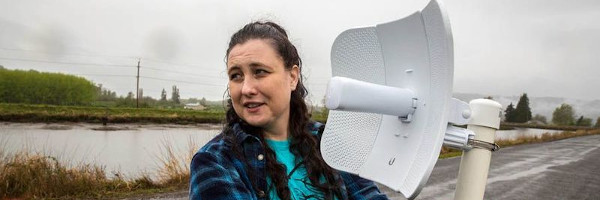Connecting Rural School Children for Distance Learning
| Connecting Rural School Children for Distance Learning | |
|---|---|

| |
 Deborah Simpier, co-founder of Althea, holds an antenna that broadcasts internet service through a decentralized network | |
| Team Organizations | Joint Venture Silicon Valley |
| Team Leaders | Wilfred Pinfold |
| City, State | Independence OR |
| Contributors | David Witkowski Mohammad Shakouri |
| Website | Website |
| Document | Download |
Description
As the SARS-COV-2 virus spreads, and communities work to minimize COVID-19 cases, schools are closing and we expect all school physical facilities will remain closed for some period of time during this emergency. This will affect more than 76 million students across the US.
Many closing schools are shifting to online learning, but this transition won’t be easy. Students need three things to engage in successful distance learning; a suitable computing device, access to high-speed internet, and digital literacy. According to 2017 data from the National Telecommunications and Information Administration (NTIA), 3.1 million households (14.1%) with school-aged children have no wired broadband connection at home. Pew Internet's 2019 Mobile Technology and Home Broadband Fact Sheet found that 17% of Americans are "smartphone only" internet users. However, in most cases those data plans aren’t typically sufficient for extended online learning. Rural residents face the additional challenge of living in areas that are often not well covered by high-speed cellular broadband, and where wired broadband service is either slow or non-existent.
The SARS-COV-2 pandemic highlights our country’s existing deep digital divides. Simply put, too many American children live without essential internet services.
In addition to education our schools provide meals for low-income students. Parents who work in essential positions need child care, and schools provide children with opportunities for needed social interaction.
Challenges
- Providing broadband connectivity to all children regardless of family income.
- Providing suitable computing devices.
- Promoting digital literacy to all children.
- Delivering nutritious meals to low-income students.
- Delivering child care to families with parents who are essential workers.
Implementation
To address this challenge, we need to balance economics against technology. The most economical path will likely leverage existing commercial technologies, yet applied in creative ways. Variations in terrain, user population density, available resources for siting, electrical power, and connectivity to the network (aka “backhaul”) will require that each solution be engineered for the location, but by using proven commercial technologies we can adjust as needed to balance for performance, cost, and user density.
Broadband is defined by the Federal Communications Commission as a connection that reliably provides download speed of 25 megabits per second (Mbps), and upload speed of 3 Mbps, or what is often called in technical jargon “25/3 service”. Some states define broadband as 10 Mbps of download, and 1 Mbps of upload, or “10/1 service”. The backhaul connection between the broadband distribution site and the internet must scale with the target number of users; if a network serves 10/1 Mbps broadband to 1,000 users, the backhaul connection must be able to sustain at least 10 gigabits per second (Gbps) of download and 1 Gbps of upload.
Success Factors for Wireless Broadband Networks
Any broadband network serving multiple users simultaneously needs to successfully address several factors:
- High bandwidth connection to the internet. This is known as “backhaul”.
- Electrical power for the networking and wireless equipment.
- A physical enclosure for the networking and wireless equipment.
- A method for mounting antennas, typically on a mast or tower.
- Physical security for the enclosure, electrical, and backhaul cabling.